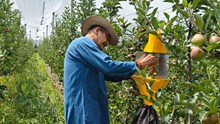
From the quiet ponds of Mithilanchal to the shelves of global health stores, Makhana—once a humble, unknown aquatic crop—has been transformed into a celebrated superfood. At the heart of this revolution stands Dr. Shyam Narayan Jha, a visionary Agricultural Engineer and world-renowned scientist whose relentless pursuit of innovation and persuasion for the crop turned a traditional, labor-intensive practice into a thriving industry. Often working in anonymity, Dr. Jha's dedication over the past 36 years has not only mechanized makhana processing but also elevated the socio-economic status of lakhs of farmers and other stakeholders across India and abroad.
Krishi Jagran (KJ) found that a single person, Dr. Jha is common in all pursuit of makhana development and thus wanted to talk with him. In an exclusive interview with KJ, Dr. Jha opens up about the trials, breakthroughs, and unwavering spirit that fuelled the makhana movement—and how one promise made in a remote village in Bihar reshaped an entire ecosystem.
KJ: Dr. Jha, Makhana has emerged as a superfood on the global stage. How did your journey with Makhana begin?
Dr. S. N. Jha: My journey began back in 1988–89 when I was an M.Tech student at IIT Kharagpur. I had something in my mind—that I should do some work for my region while being at IIT. In search of a topic, various options for Madhubani district were checked with my relatives. In the process, I visited Narayanpatti village in Madhubani, Bihar, and was deeply moved after witnessing the severe injuries—rashes, burns, wounds, smoky environment—on the hands and faces of people engaged in traditional makhana processing. An elderly man there told me, “Son, a machine cannot produce makhana lava from seeds coming out of the makhana plant. It is difficult and next to impossible. But if you invent one, you’ll be like a god to us.” That moment changed everything for me. I decided to take up makhana as my research project.
KJ: That must have been a huge challenge. How did you manage to pursue research on a topic like makhana?
Dr. Jha: Indeed, it was challenging. At IIT Kharagpur, no one even knew what makhana was. Initially, I couldn’t even find an advisor for my thesis. I went from one professor to another professor, carrying makhana seeds in one pocket and popped makhana in the other. I used to take them out to explain to people what I was working on. Eventually, Prof. Prasad in the Post-Harvest Technology Centre, finally, after a lot of persuasion, agreed to supervise my work, and the journey of makhana development started.
KJ: That’s remarkable persistence. How did you begin working on the makhana processing machine, and were there any major setbacks during the initial development?
Dr. Jha: I began by going back to Madhubani and staying in several villages for a month to learn the traditional techniques firsthand. My classmates helped me identify the English and botanical names—Gorgon nut and Euryale ferox. Since there was no existing literature on makhana processing, I had to write all the unit operations in Maithili and build everything from scratch. But the journey was filled with several roadblocks. I used to bring quintals of seeds by train to Kharagpur and experiment for months without getting a single popped makhana.
With my thesis deadline approaching in December and no results in hand, one professor advised me to shift focus from the machine and collect some data related to seed properties to have something for the thesis; otherwise, without a thesis, there was a threat to my degree on time. The advice was accepted, and I started making samples for such a study.
Then came the breakthrough—while roasting seeds with Mr. H. K. Khan, a mechanic from Saharsa, we put samples of 100 seeds immediately after roasting in the machine kept near the roasting site, and to our surprise, all 100 seeds popped perfectly. The quality was even better than the makhana being popped traditionally. That moment changed everything. That was the turning point of my dream coming true. But the problem was that I did not know how it happened.
KJ: That must have been an emotional moment.
Dr. Jha: Absolutely. I ran straight to my advisor's room and later with him to the Head of the Department, Prof. Satish Bal. They also stood from their chairs and asked how it happened, finally. But I said I do not know, and no one had an explanation. After that, I studied all our data in the hostel carefully and calmly, and then I redesigned the roasting part of the machine. Finally, the machine began to work—though it had to be operated partially manually. I became a sort of campus celebrity. Even the Director of IIT Kharagpur visited my workshop several times to see the brand-new concept machine for makhana popping.
KJ: After your M.Tech, how did your journey with makhana continue, and did it lead to further innovations?
Dr. Jha: After my M.Tech, I went to Patna several times to meet officials of the Agriculture Department and Industry Department to get this machine made and implemented in Bihar, but none of them gave it importance. During a Patna visit, a Hindustan Times correspondent met me in the Horticulture Department, and he first published the news of the development of makhana popping in Hindustan Times on May 17, 1990. Even then, there were no takers. Then I decided to pursue my Ph.D. on the same topic and continued refining the makhana processing machine. I joined RAU, Pusa as a Subject Matter Specialist and later cleared the Agricultural Research Service exam.
In 1994, at NAARM, Hyderabad, I, along with my colleague, made the first video on makhana as part of training. Then, I was appointed as a scientist at NDRI, Karnal, where I wasn’t officially allowed to work on makhana initially, but I cleverly proposed a project to develop an instant makhana kheer mix, which got approved. I moved here and there, but never left the makhana. It remained a part of me wherever I went. Continued work led to several innovations—I broke the myth that popped makhana must be roasted before making powder. The first patent was filed on the concept of instant makhana kheer mix, and the same was granted after improving the technology further.
One important thing I will tell today is that during the inauguration of the Model Dairy Plant at NDRI, I met Union Minister Late Chaturanan Mishrajee. Since he was from my constituency, he asked me if I needed any help from him. I then urged him to establish a National Research Centre for Makhana in Bihar and submitted a small write-up and a few published papers by me, and a few years later, I came to know that the NRC Makhana was approved. That was a proud moment for me, but no one knows about this small initiative that bore long-lasting fruits.
KJ: Were you eventually able to work at the National Research Centre for Makhana, and did the machine finally become a reality?
Dr. Jha: Initially, no. Actually, I was appointed through direct recruitment as a Senior Scientist at ICAR-CIPHET, Ludhiana, where I was working a little bit on makhana to satisfy myself, but officially it was not my assigned work. Later, during visit of the then DG Dr. Mangla Rai jee to the newly established NRC Makhana, he was told by someone that the biggest challenge for makhana is the mechanization of its popping process, and that only could be done by me in India.
I was then transferred to NRC Makhana in Darbhanga around 2009–2010, but due to limited infrastructure in Darbhanga and other nationally important projects I was handling at Ludhiana, I requested to continue developing the machine in Ludhiana. The work on this crop then again accelerated. The third model was built in Darbhanga, but it didn’t function optimally.
Eventually, it was brought back to Ludhiana, and I resumed work under mounting pressure from ICAR. Dr. R.K. Vishwakarma, a scientist, was attached with me upon my request to help, as I was handling many official responsibilities and projects. With strong support from senior ICAR officials like Dr. M.M. Pandey, the then DDG (Agricultural Engineering), and Dr. Mangala Rai, former DG ICAR—whose interest greatly helped—we received support from all corners, and finally, a commercial prototype came out.
It was licensed to a manufacturer in Ambala, and we (myself and Dr. Vishwakarma) personally conducted several demonstrations and melas with this machine in 2013 in Darbhanga and Madhubani. That day, I was the happiest person on this earth when I felt I had fulfilled the promise I made to that elderly man back in 1988.
KJ: How did the makhana industry evolve after that?
Dr. Jha: The impact was huge. Now we have developed machines for cleaning, grading, popping, and making value-added products like fat-free spiced makhana and instant makhana kheer mix. We are now working on a harvesting machine and aiming to utilize by-products. My latest contributions include giving the name Mithila Makhana to makhana for GI registration, getting a dedicated HS code for export, FSSAI standards, conducting clinical trials for its health benefits, and trying hard to help re-establish NRC Makhana as a national institute, which it had lost sometime after its approval.
KJ: What has been the national recognition of your efforts, and how do you feel looking back at your journey?
Dr. Jha: The recognition has been deeply gratifying. I was given the Rafi Ahmed Kidwai award (the highest level individual award of ICAR), the NRDC award for societal innovation of this kind, and many more such national recognitions. The most satisfying thing is that makhana does not now require much introduction.
Union ministers and even the honourable PM himself have spoken several times about makhana. Its trade has increased by 60–70% in the last three years. The cultivation area has more than doubled and is expanding beyond Bihar to states like Telangana, Odisha, Uttar Pradesh, Chhattisgarh, and more. Now, the Government of India has announced the Makhana Board, and I’ve had the privilege of being involved and contributing to establishing the Makhana Board. People are so crazy about makhana that I have even delivered lectures for consumers and business persons from the US and other countries.
I get a few calls every week for one or another kind of help in establishing makhana businesses. Seeing the high demand and expectations from me, I started my own website, www.snjha.in, and put all information about makhana here freely available to the public. They put their questions and doubts here, and I usually reply to them free of cost. A lot of work is needed on makhana, and makhana is my passion, my first love. Though I am also known as a pioneering researcher for non-destructive evaluation of food quality in India, I will be working on makhana and its development till my last breath.
Looking back on this journey of over 36 years of Dr. Jha — from IIT Kharagpur to being called the “Makhana Man of India” — it’s been emotional, challenging, and immensely rewarding. The KJ feel proud that Dr. Jha has contributed unimaginably high for the development of makhana, helped improve the lives of lakhs of people, and built the economy of the Nation. Makhana has grown into a movement, and he is at the centre stage of it. In other words, we can call him the Janak of makhana development in India and abroad.
(Curated and Written by Shivam Dwivedi)















Share your comments